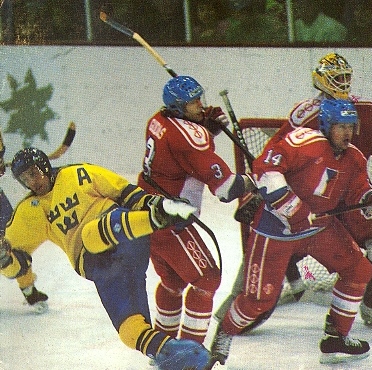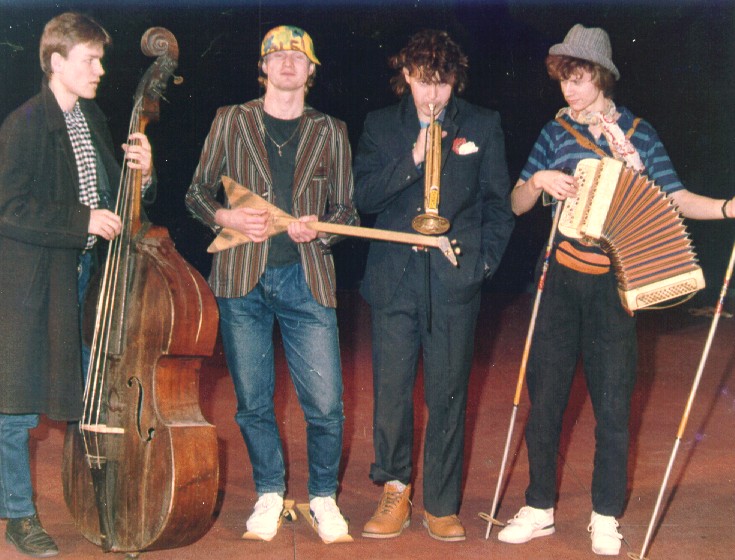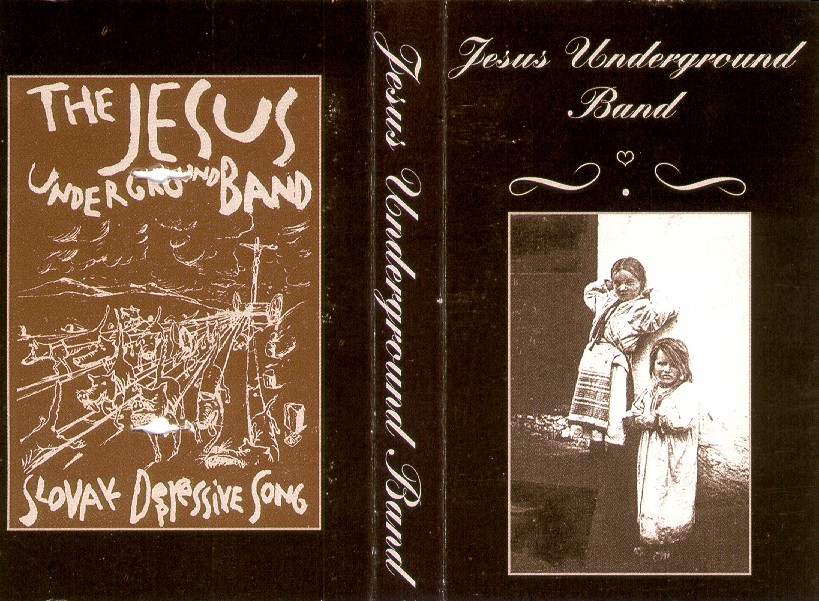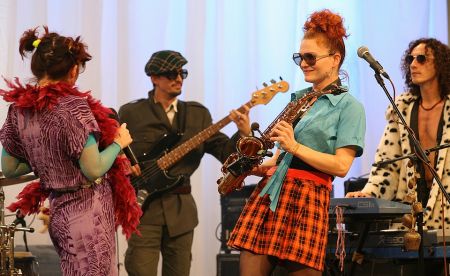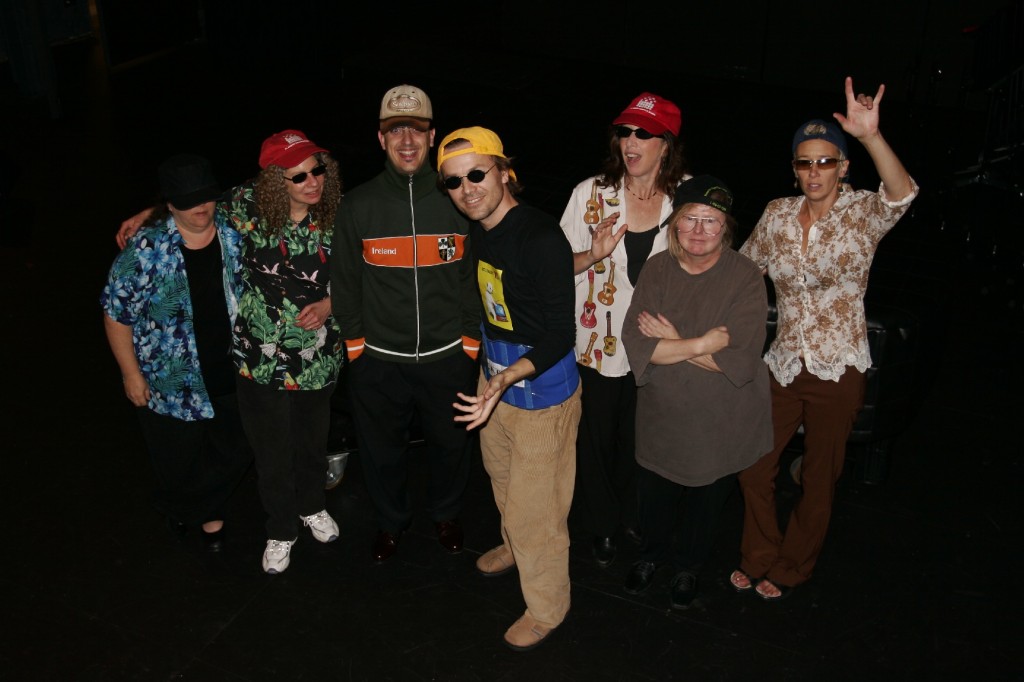Abstract:
The article deals with the transformations of various jazz style elements in the projects of Slovak musical alternative in the post-modern times, and their appropriations by the form of trans-genre re-contextualisation and fusion, or a persiflage and a parody. Their qualities and specificities will be demonstrated on the records and performances of Slovak alternative rock groups in the last two decades of the 20th century (Ali Ibn Rachid, Teória Odrazu, Jesus Underground band, and 100 Múch), and of contemporary composers or “comprovisers” (Andrej Šeban and Július Fujak). Style-genre mutations of jazz or jazzrock idioms in the works and the projects of Slovak alternative music will be reflected on using the method of aesthetic interpretation of their signification in the musical and cultural context.
Some forty years ago Frank Zappa said: “Jazz is not dead, it just smells funny…!“ This statement can be considered as controversially witty, but Zappa, in fact, identified something stagnant, rigid and academic in jazz music. In the last decades of the 20th century there was an effort by different puritans to keep jazz “clear” and to preserve it as a kind of “mummy in the museum”. It is no wonder that many musical artists began to create various pieces by the methods of parody or persiflage of this jazz purism, or to transform vivid jazz style elements and appropriate them in the manner of trans-genre re-contextualization.
Originally, jazz was a unique musical phenomenon with special and typical mutually correlated idioms, which include, for example:
– different types of and approaches to solo or collective improvisations;
– specific vocabularies and expressions associated with original and unique ways of interpretation;
– collective “comprovised”1 creations of music based on cooperative dialogical musicianship;
– specific correlations between melodic-harmonic, modal, (poly)rhythmic and sonoristic musical thinking;
– the creation of music in a “studio as a musical instrument“ (this term was introduced by B. Eno), which offers special, different and various possibilities;
– revivable qualities to fuse and bind with different kinds of music and genres (ethnojazz, fusion, jazz-rock, nu jazz, etc.);
– an inherent ability to transgress its boundaries (at least till the turn of 1980s/1990s);
– last but not least: a deep connection between artists’ approach to creating jazz music and their ways of life; regarding this point we can mention Peter Niklas Wilson´s thought on “the aspect of the existential state of complete knowing of the Self and the identity”(Wilson 2002: 35).
All of these principles have been very inspiring for other kinds of music including rock (progressive or alternative), improvised music, or avant-garde (post-)modern composed music.
If we speak about a trans-genre re-contextualization of other musical genres and semiotic readings of music style „quotations“ in the context of so called speech of genres, we cannot neglect several works of art. Their composers invented peculiar ways of musical mutations, re-interpretations, and re-contextualisations – sometimes also as an expression of parody, persiflage, irony, or sarcasm – but they demonstrated the methods of musical transformations of quoted styles as well.
Igor Stravinskij in his famous music for the ballet Pulcinella (1920) used and quoted some motifs and even the harmonies from Giovanni Battista Pergolesi´s music, which he shifted slightly into the context of modern harmonies; for those who considered Stravinskij as a prominent avant-garde composer of the time, this approach was shocking. Sergej Ďagilev originally refused this piece (which he had ordered for his Russian ballet company in Paris), because he saw it as an ironic outrage against classicism. But Stravinskij only wanted to portray early 18th century music in the style of modern neoclassicism, and create with it a special dialogue from the position of modernist composer.
Paul Hindemith created a fascinating trans-genre palette in his grand oratory Jeanne d’Arc au bucher (Joan of Arc, 1935), where he put in – even a controversial – confrontation between various scenes and the contrasting “commenting” musical styles from different historical eras, which transformed the scenes’ meaning. We can mention pars pro toto the well-known court scene with a stylisation of baroque counterpoint in contrast with the animal tribunal judging and condemning St. Joan of Arc.
More than thirty years later Frank Zappa and his group Mothers of Invention created their first album (actually the very first conceptual 2-LP), Freak Out! (1966). In the first half of this project Zappa parodied and travestied typical pop songs of the 1960s by quoting typical simple chords and by tectonic structure, with a vocal parallelism in the style of the Bee Gees and the Beach Boys, with funny, absurd and sarcastic lyrics. He explained that he had employed the same method of trans-genre appropriation as Igor Stravinskij.
In the 1980s John Zorn devoted his attention to musical works which used the “patchwork” principle consisting of a juxtaposition of extremely distinct style-genre elements (in horizontal and vertical temporal cross-sections) following one another in fast and surprising sequences. Zorn admits that he was, at that time, inspired by the logic of the comics and cartoons he had often watched as a child. The result of this approach can be heard, for example, in his works Spillane (1987), in some of bizarre Film Works, or in selected parts of the live performances of his group Naked City (at the turn of 1980s and 1990s).
The post-modern situation in (not only) musical art has changed many aspects in understanding and perception of music. As the Slovak aesthetician, curator and conceptual artist Jozef Cseres writes, contemporary artists attack even the ontological substance of the media, their spatial-temporal coordination, and their limitations. Musical works are not restricted anymore by even temporal frames of repeated live performances, or mechanical-electronic reproductions (Cseres, 2004, p. 46). Cseres is aware of the very important role which music also plays in the (post-)structuralistic discourses of C. Lévi-Strauss, J. Attali, R. Barthes, G. Deleuze and F. Guattari, and in their concepts of music, silence, noise, rhythm, refrain, language, code, and meaning.2 We can ask if contemporary jazz music trends reflect and express these significant changes. I think that many recent jazzmen still look to the admirable history of the past and do not reflect the contemporary post-modern, “Babylonian” plurality of the world. The more they walk in the museum of foretime, the more they become non-topical, sterile and ridiculous.
It is no wonder that in Slovakia there are also many groups and exponents of alternative music who revitalise, transform (or travesty) jazz music through various ways of re-interpretation or re-contextualization. The decade around the turn of 1980s and 1990s was a very interesting period in Slovakian alternative rock music, when – among many others – unique groups appeared, e.g. Maťkovia of Martin Burlas, Bez Ladu a Skladu, Ali Ibn Rachid, Teória Odrazu, and Jesus Underground Band (JUB). The last three groups appropriated some jazz elements in a more explicit way.
Ali Ibn Rachid, in their very first album (1991) created bizarre songs by combining progressive rock, composed “fusion”, jazz, a sort of cabaret, and a kind of intentionally naive vocal expression. (The singer and leader Ľubomír Burgr sometimes also sang in the eastern Slovakian dialect.) Ali Ibn Rachid belonged to the most sophisticated groups of their generation but, on the other hand, they were also characterised by absurd humour. For an example we can point to the song “Letný sneh práve napadol” (Summer snow has just fallen) whose introduction is based on the hard, “lazy” rhythm of drums and bass, and on a “crying” glissando solo of the tenor saxophone above it, which evoke the jazz cabaret atmosphere of the 1950s European jazz clubs. The absurd lyrics are in a perfect tension and contrast with the intelligent arrangement of the brass section; it is composed and played in the spirit of a “trans-jazz” feeling.
The cover of Ali Ibn Rachid’s first LP (1991)
Teória Odrazu (Theory of Reflection – the name of the group was identical with the official socialist theory of arts) was a special rock-alternative band focused on collage of various styles – hard rock, fusion, ethno inspirations, jazz, all together with Zappa´s mixture of trans-genre unexpected changes of rhythm, harmonies, dynamics, etc. The singer Peter “Šteko” Štekláč also played the bugle, an old rather misshapen military horn, which disturbed any definiteness about the musical styles played by the band. Štekláč on this instrument performed some crazy free jazz “extracts”, Slovakian folk melodies, and he also imitated Miles Davis´s sound. Besides funny parodies of swing and fusion, as well as a heavy metal and martial march, the band dedicated his slow funeral silent song Tu (Blow) in memoriam M. Davis (1992).
Teória Odrazu (1991)
The Jesus Underground Band (JUB) was able to combine hard core, free jazz, noise and even a simple baroque counterpoint. They also enlarged the instrumental cast of “classical” alternative rock groups with a clarinet and a bugle, but the main difference between the Jesus Underground Band and the other groups lay in JUB’s staging of “cruel rituals”, e. g. scenes with the beating and kicking a man on the stage while playing all his painful “screams” on the brass instruments (1995). The band’s way of using the “free jazz” principle can be characterised, in this context, as an example of extreme “site specific” re-contextualization.
The cover of Jesus Underground Band’s MC record (1995)
A parody of certain jazz aesthetics has appeared in Space Boys, the CD album of the Andrej Šeban & Tono Kubasák duo (2005). In the piece “Jazz Klab” they simply quoted in a very ironical way different void virtuoso solo parts, inappropriate scat, simulated jazz singing, conventional fusion chords played on a synthesiser, etc. Behind these layers there are samples of clapping and of animated jazz club audiences.
Another Slovakian alternative rock-funky band, 100 Múch (100 Flies, originally Too Much) has started to create interesting songs and compositions since the first decade of the 21st century. (The musical producer of their first album was A. Šeban.) We cannot say that they use the methods of parody or persiflage of jazz, however, they have developed poly-rhythmical and bi-tonal mutations of funk, (post-)modern jazz and the Slavonic modality. I think that the song “Trolejbus” (Trolleybus) from the band’s second CD Fšehochuť (2008) suggestively expresses all these mutations.
100 Múch (2008)
In my musical works I also apply certain transformation, semantically shifted re-interpretation of jazz idioms with a deep respect to modern (especially avant-garde) styles including progressive fusion music of the 1970s and the 1980s. Here are two examples: in 1998, I composed for students of the VŠMU (the Academy of Performing Arts) in Bratislava the music for their staging of Woody Allen’s comedy Play It Again, Sam, so a jazz stylisation was welcomed and requested for such a theatrical play. Along with a mix of fragments from modern jazz vinyl records, I also prepared more than ten jazz themes, which the young saxophonist Martin Koróny improvised in typical “soft mood” variations with me on the piano, synthesizer and sampler. For example, in the track “Joystick Jazz II” I transformed some “classical” jazz harmonies which were, in the second half of the piece, interrupted and disturbed by a glissando of noisy electrical low sound. (At that time, I took inspiration from the computer music by Martin Burlas who had appropriated unexpected breakdowns of his digital equipment as a sonic source of his music.)
Jazz elements as well as a collective way of impro-/comprovisation were implemented in my “intermedia wrestling” transPOPsitions! (2003/rev.2005). The piece was based on a confrontation between contemporary non-conventional music (involving jazz stylisations) and pop video-clips (of Robbie Williams, Michael Jackson and Eminem); the interludes contained phrases which were taken from the well-known Roland Barthes´ text Wrestling, and were projected on a big screen. The composition was performed in a revised and extended version in 2005 by the prominent chamber ensemble the California EAR Unit with me as a guest on stage at the Red Cat Theatre in Los Angeles (not very far from the pop cultural centre, Hollywood, USA). TransPOPsitions! was a special (inter)semiotic game, a kind of bizarre “fighting” dialogue in the form of intermedia wrestling between the pop (visual) culture and mutations of contemporary improvised and composed music with jazz motifs. I tried to create music that would maintain the spirit of jazz and early pop music of the era hundred years ago; I only wanted – especially in the interludes – to bring a certain ironic context into it when the audience was reading the sentences from Barthes´ study.
The EAR Unit with Julius Fujak (in the middle) after the transPOPsition performance in Los Angeles in 2005
These examples from Slovak alternative music scene demonstrate the abilities of trans-genre games with re-contextualised jazz music – either in the sense of parody, persiflage and ironic sarcasm, or in transversal style mutation – which can result in a special, sometimes bizarre, new and taxonomically indefinable musical quality.
Yes, Zappa was right, maybe jazz did smell funny then. But if some of its styles did not endure and started to be “bedraggled” by other kinds of music, binding and melting with them into a symbiosis in various contexts, jazz has thus shown us how vivid it can be even in recent times.
Notes
- My understadning of the „comprovisation“ notion is explained in „Comprovisation: Notes pour une discussion sur la validité de la notion“, In: Improjazz. ISSN 1269-6501, vol. 14, no. 182 (2012), pp. 31-35. More on the subject of „comprovisation“ in the English language is also available on the website: http://sme.amuz.krakow.pl/cageconf/notes/.
- In particular, more can be found in his paper Cseres, Jozef: “Hudba, Etnológ, Ekonóm, Semiológ a Pojmotvorci” (z cyklu metaxu) (Music, Ethnologist, Economist, Semiologist, and Conceptmakers (from the series metaxu (metaxu)). In: Fujak, Július (ed.): Otáz(ni)ky hudobnej semiotiky a estetiky (Questions on Musical Semiotics and Aesthetics). Nitra : UKF, 2010, pp. 107 – 118. ISBN 978-80-8094-693-7.
Bibliography
CSERES, Jozef: “Site & Room”. In: Era21, ERA, Brno, no. 3, 2004, pp. 46-47, ISSN 1213-6212
CSERES, Jozef: “Hudba, Etnológ, Ekonóm, Semiológ a Pojmotvorci” (z cyklu metaxu) (Music, Ethnologist, Economist, Semiologist, and Conceptmakers (from the series metaxu (metaxu)), In: Fujak, Július (ed.): Otáz(ni)ky hudobnej semiotiky a estetiky (Questions on Musical Semiotics and Aesthetics). UKF, Nitra 2010, pp. 107 – 118. ISBN 978-80-8094-693-7
FUJAK, Július: “Comprovisation: Notes pour une discussion sur la validité de
la notion”, In: Improjazz, vol. 14, no. 182, 2012, pp. 31-35, ISSN 1269-6501. The
English version: “Comprovisation – Notes to a Discussion on the Validity of the
Notion”. In: Filozofické koncepcie v hudbe a umení, Hudobná a
umelecká akadémia Jána Albrechta, Banská Štiavnica, pp. 25-30, ISBN 978-80-970754-4-6
WILSON, Peter Niklas: Hear And Now. Úvahy o improvizovanej hudbe. (Hear and Now. Considerations on Improvised Music),Trans. by Slavomír Krekovič, Hudobné centrum, Bratislava 2002, ISBN 80-88884-35-7

